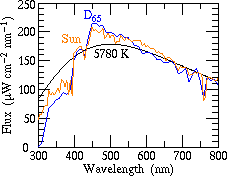Blackbody
The above is supposed to show, as accurately as possible on a computer screen, how the colour of a radiating blackbody varies with its temperature. The two vertical bars of colour at each end of the colour chart are the colours at zero and infinite temperature. Evidently the limiting colours are not much different from the colours at 1,000 K and 50,000 K. I confess a little disappointment at the high temperature result: I was hoping that the colour there would be more violet.
The blackbody colours in the colour chart at top and in the diagram at right
were computed by integrating the monochromatic tristimuli
\(X\), \(Y\), \(Z\) from the
CIE 2° tables
over a Planck distribution.
The resulting blackbody tristimuli were
transformed to
\(R\), \(G\), \(B\),
then gamma-corrected to
\(R\)¢, \(G\)¢, \(B\)¢,
as described on the
Blackbody colours at temperatures around 5000–7000 K are nearly white, and the choice of white point is important if one wants to render these colours accurately. On these pages I have adopted CIE D65 as white, but of course this may not accurately represent the white point \(R\) = \(G\) = \(B\) of your monitor. Introduced by CIE in 1963, the D series of standard illuminants are intended to represent ‘daylight’ at various correlated colour temperatures, with D65 to be used whenever possible. The precise (slightly complicated) definition of these illuminants can be found in R. W. G. Hunt (1987) “Measuring Colour”. The ‘correlated colour temperature’ is the temperature of the blackbody that is, in a certain well-defined sense, nearest in colour. The subscript 65 on D65 signifies a correlated colour temperature that was originally 6500 K, but thanks to a revision of the combination \(hc/k\) of fundamental constants in the Planck formula is now defined to be (1.4388/1.4380) 6500 K \(\approx\) 6504 K (the 2014 NIST value is \(hc/k = 1/0.69503457~\textrm{cm K} = 1.438777~\textrm{cm K}\), but apparently the definition of correlated colour temperature has not been revised again). |
Sun The Sun has an effective surface temperature of 5780 K.
However, the Sun’s spectrum is not a precise blackbody.
The graph at right shows the spectrum of the Sun as seen from above the Earth’s
atmosphere, together with the spectrum of a blackbody at 5780 K
with the same total flux as the Sun,
and the spectrum of CIE D65 ‘daylight’
normalized to the solar flux at 560 nm.
The Sun’s spectrum was taken from
R. L. Kurucz, I. Furenlid, J. Brault & L. Testerman (1984)
Solar Flux Atlas from 296 to 1300 nm.
The spectrum in the Solar Flux Atlas has a resolution of
\(\lambda / \Delta\lambda \approx 160{,}000\).
The spectrum plotted at right is heavily binned, into 5 nm bins.
A table of the spectral energy distribution of CIE D65 is available
at the
Color and Vision Research Laboratory.
The Sun has an effective surface temperature of 5780 K.
However, the Sun’s spectrum is not a precise blackbody.
The graph at right shows the spectrum of the Sun as seen from above the Earth’s
atmosphere, together with the spectrum of a blackbody at 5780 K
with the same total flux as the Sun,
and the spectrum of CIE D65 ‘daylight’
normalized to the solar flux at 560 nm.
The Sun’s spectrum was taken from
R. L. Kurucz, I. Furenlid, J. Brault & L. Testerman (1984)
Solar Flux Atlas from 296 to 1300 nm.
The spectrum in the Solar Flux Atlas has a resolution of
\(\lambda / \Delta\lambda \approx 160{,}000\).
The spectrum plotted at right is heavily binned, into 5 nm bins.
A table of the spectral energy distribution of CIE D65 is available
at the
Color and Vision Research Laboratory.
The colour of the background of this page and accompanying pages on this site is the colour of the Sun relative to D65 white. As shown in the table, the Sun’s colour is in fact rather similar to that of a 5780 K blackbody. It looks peach pinkish, not yellow, doesn’t it? Strange. But I think it’s a pretty colour. It has to be emphasized that white is a relative thing, at least to a certain extent. It is relative to the D65 white that the Sun is peachy pink. Item 16 of the Color FAQ states that for most people D65 has a little hint of blue. So maybe the Sun is really white? |
Update 23 Jan 2017: Mitchell Charity suggests to use D58 rather than D65 to represent colours of stars on the screen. He correctly points out that the Sun's colour is pinkish compared to D65, but that is only because D65 is bluish compared to the Sun. Relative to D58, the Sun is whitish. That is certainly true. What your brain perceives as white is a complicated thing that depends in part on ambient lighting and surrounding colours (D. Falk, D. Brill & D. Stork 1986 “Seeing the Light”). To me the surprise was that I had expected the Sun's colour to be yellowish, as we had been taught in kindergarten. Point to ponder: Would it be legitimate to define a white point such that the Sun appears slightly yellowish?
Star colours
|
Updated 19 June 2001